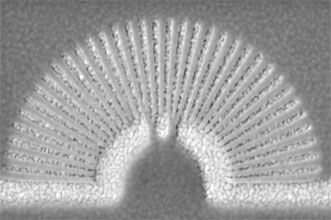A new metamaterial design has enabled a hyperlens capable of imaging details smaller than the wavelengths of visible light.
Developed at The State University of New York at Buffalo, the new device relies on a nonresonant, waveguide-coupled design to overcome the losses previous hyperlenses suffered at optical wavelengths.
"There is a great need in health care, nanotechnology and other areas to improve our ability to see tiny objects that elude even the most powerful optical systems," said Natalia Litchinitser, professor of electrical engineering at Buffalo. "The hyperlens we are developing is, potentially, a giant step toward solving this problem."

A metamaterial hyperlens. The light-colored slivers are gold, and the darker ones are PMMA. Courtesy of University at Buffalo.
Diffraction sets a fundamental limit to the resolution of optical systems, but metamaterials provide a potential route around this barrier.
Typically optical metamaterials are arranged in repetitive patterns, often smaller in scale than the wavelengths of the phenomena they influence. Metamaterial hyperlenses overcome the diffraction limit by transforming decaying evanescent waves into propagating waves. Once converted, the evanescent waves, which were commonly lost in conventional imaging, can be collected and transmitted using standard optical components.
Some of the first metamaterial hyperlenses consisted of tiny concentric rings of silver and a dielectric material. However, this design only works within a narrow range of wavelengths and suffers from large losses of resonance.
The Buffalo researchers took a different approach, forming tiny slivers of gold and the transparent thermoplastic PMMA into a radial shape. The design of this metamaterial hyperlens – which looks like a Slinky toy suspended in motion – overcomes the diffraction limit in the visible frequency range. Moreover, it can be integrated with an optical waveguide, opening the door to hyperlens-based medical endoscopes.
More study is required, but such a tool could improve doctors' ability to detect some of the most lethal forms of cancer, such as ovarian cancer. For example, today's high-resolution endoscopes can resolve objects to about 10,000 nm. The hyperlens could improve that to 250 nm or better.
Another potential application centers on optical nanolithography, the process of passing light through a mask to create a pattern on polymer film. Continuous improvement in this field is essential to building the next generation of optoelectronic devices, data storage drives, sensors and other gadgets.
The researchers said their hyperlens also show promise in sequencing single molecules, a potential advancement with broad implications in numerous fields of research including physics, chemistry and biology.
Funding came from the U.S. Army Research Office and the National Science Foundation.
The research was published in Nature Communications (doi: 10.1038/ncomms8201 [open access]).
For more information, visit www.buffalo.edu.